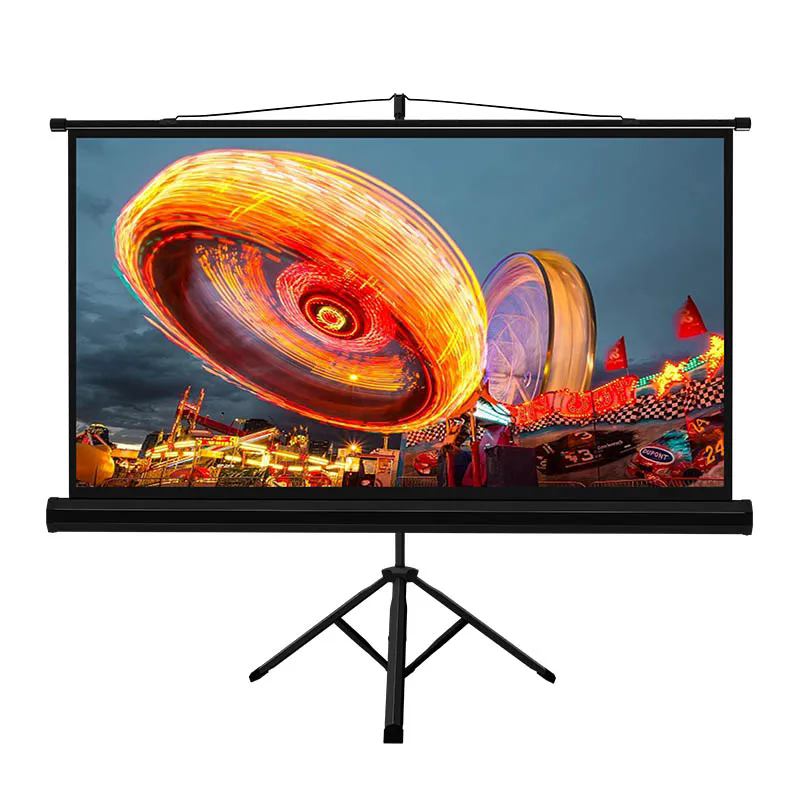The Versatility of Tripod Projector Screens: A Comprehensive Guide
2024-08-23
In the world of presentations, home theaters, and outdoor movie nights, a tripod projector screen stands out as a highly versatile and practical solution. Whether you're setting up a business presentation, enjoying a family movie, or hosting an outdoor event, a tripod projector screen offers flexibility, ease of use, and high-quality projection. In this blog, we will explore the benefits of tripod projector screens, their various applications, and tips for choosing the perfect one for your needs.
What is a Tripod Projector Screen?
A tripod projector screen is a portable screen that comes mounted on a tripod stand. This design allows the screen to be easily set up, adjusted, and taken down without the need for permanent installation. The tripod base provides stability, while the adjustable height mechanism enables users to position the screen at the optimal viewing level.
Benefits of Using a Tripod Projector Screen
1. Portability: One of the primary advantages of a tripod projector screen is its portability. The lightweight and collapsible design make it easy to transport and set up in various locations, making it ideal for both indoor and outdoor use.
2. Ease of Setup: Tripod projector screens are known for their simple setup process. The tripod stand allows for quick assembly and adjustment, so you can have your screen ready for use in just a few minutes.
3. Adjustable Height: The tripod stand features an adjustable height mechanism, allowing you to position the screen at the perfect viewing level. This feature is particularly useful in environments where the seating arrangement or audience height may vary.
4. Stability: Despite its portability, a tripod projector screen provides a stable viewing surface. The tripod base ensures that the screen remains upright and secure during use, reducing the risk of tipping or wobbling.
5. Versatility: Tripod screens are suitable for a wide range of applications, from business presentations and classroom settings to home theaters and outdoor movie nights. The flexibility of the design allows it to adapt to different environments and needs.
6. Affordability: Compared to other types of projector screens, tripod screens are often more budget-friendly. They offer a cost-effective solution for those who need a reliable and high-quality screen without breaking the bank.
Applications of Tripod Projector Screens
1. Business Presentations: In a professional setting, a tripod projector screen is an essential tool for delivering effective presentations. Its portability allows you to easily set up the screen in various meeting rooms or conference settings.
2. Classroom Settings: Educators can benefit from the versatility of a tripod projector screen. It can be used to display educational materials, multimedia presentations, and interactive content in classrooms of all sizes.
3. Home Theater: For a home theater setup, a tripod projector screen offers a convenient and flexible option. It allows you to enjoy a cinematic experience in different rooms or even take it outdoors for a backyard movie night.
4. Outdoor Events: Tripod screens are perfect for outdoor movie nights, parties, and community events. Their portability and ease of setup make them a popular choice for creating a temporary viewing area in parks, backyards, or other outdoor locations.
5. Trade Shows and Exhibitions: At trade shows and exhibitions, a tripod projector screen can be used to display promotional videos, product demonstrations, and other multimedia content to attract and engage visitors.
Choosing the Right Tripod Projector Screen
1. Screen Size: Consider the size of the screen based on your intended use. For business presentations and classroom settings, a smaller screen may suffice, while home theaters and outdoor events might require a larger screen for better visibility.
2. Aspect Ratio: Choose a screen with an aspect ratio that matches your projector and content. Common aspect ratios include 4:3 (standard), 16:9 (widescreen), and 16:10 (widescreen). Ensure compatibility with your projector to achieve the best image quality.
3. Screen Material: Look for a screen with high-quality projection material that enhances image clarity and brightness. Matte white and high-gain materials are popular choices, as they offer excellent color reproduction and reduce glare.
4. Adjustability: Ensure that the tripod stand allows for easy height adjustment and stability. Check the height range to make sure it meets your needs for various viewing situations.
5. Portability and Storage: Evaluate the screen’s portability features, such as weight and folding design. A compact and lightweight screen is easier to transport and store, making it more convenient for on-the-go use.
6. Durability: Choose a tripod projector screen made from durable materials that can withstand frequent use and transport. A sturdy tripod base and robust screen material will ensure long-lasting performance.
7. Price: Determine your budget and find a screen that offers good value for your money. While tripod projector screens are generally affordable, prices can vary based on size, material, and features.
Tips for Using a Tripod Projector Screen
1. Positioning: Place the screen on a flat and stable surface to ensure optimal viewing. Avoid locations where the screen may be subject to vibrations or disturbances.
2. Calibration: Adjust the projector settings to match the screen size and aspect ratio. Proper calibration will enhance image quality and ensure that the projection fits the screen perfectly.
3. Lighting: For the best viewing experience, control the lighting in the room or outdoor area. Minimize ambient light to reduce glare and improve image contrast.
4. Maintenance: Keep the screen clean and free from dust or debris. Use a soft, dry cloth to gently wipe the screen surface and avoid using harsh chemicals or abrasive materials.
5. Transporting: When transporting the screen, ensure it is securely packed and protected from damage. Follow the manufacturer’s guidelines for folding and storing the screen to maintain its condition.
Conclusion
The tripod projector screen is a versatile and practical tool that enhances various viewing experiences, from business presentations and classroom settings to home theaters and outdoor events. Its portability, ease of use, and affordability make it a popular choice for many applications. By choosing the right screen and following best practices for setup and maintenance, you can enjoy clear and engaging projections wherever you go. Embrace the flexibility of a tripod projector screen and elevate your viewing experiences to new heights!



